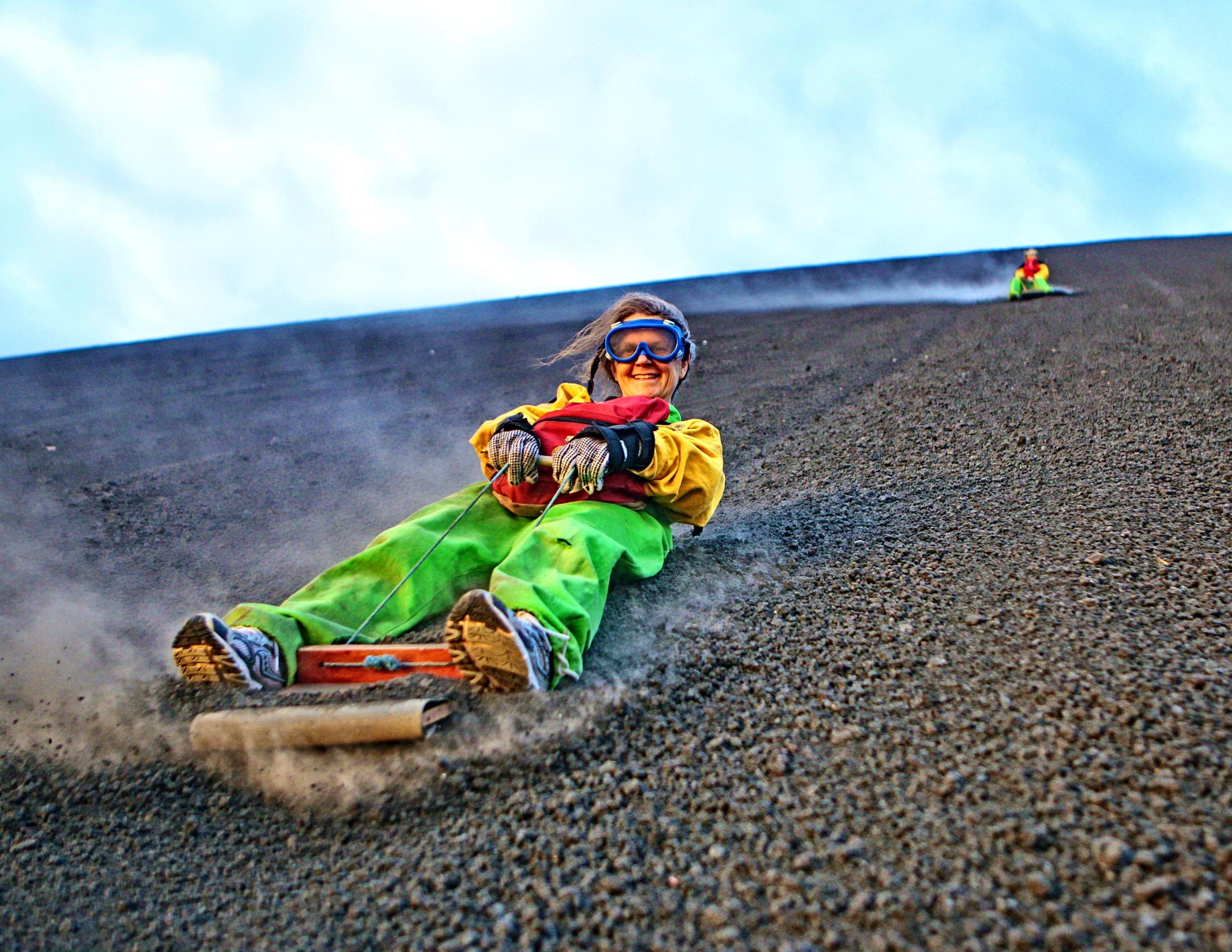Nicaragua has volcanoes in every kind of condition, from active to dormant to extinct – from smoking “gateways to hell” (as early Spanish settlers believed them to be), to tranquil, lush, greenery-covered craters. You can hike the slopes of a number of them, swim in their crater lakes, and peek over the rim into the fiery depths.
But the best way to really explore this beautifully formed Central American country’s volcanoes is by board. Forget snowboarding, sandboarding and bodyboarding – this is the (admittedly niche) adventure sport to try.
In days gone by, locals would skim down the Cerro Negro volcano in Nicaragua on old mattresses or surfboards. The process was refined a few years ago with the invention of a strapped on custom-built sandboard. Adventure doesn’t get much more adrenaline-inducing than whizzing down a 728m slope of black volcanic dust at great speed, kitted out in a jumpsuit to protect against the unforgiving volcanic terrain.
This one-of-a-kind half-day excursion from the nearby colourful colonial city of Leon starts with a steep one-hour hike up the volcano – a mere baby in volcano terms, born in 1850. But then comes the rush – the climb is followed by a rapid descent. Although speeds of up to 59mph have been achieved, I opt for a fairly sedate, sensible pace – it’s potentially a very dangerous activity, if you hadn’t already guessed.
This extreme sport may not be for everyone, but that’s no reason not to embrace Nicaragua’s diverse collection of volcanos.
Dominating Granada’s skyline (like Leon, another outstanding must-see colonial town), the 1,100m Mombacho volcano offers a range of hikes, from the steep to the less demanding. Walking routes here reveal lush, vine-clad cloud forest teeming with wildlife. There are three species of monkey on the volcano, as well as 168 species of bird and more than 100 types of orchid.
My group are lucky to see a two-toed sloth lounging on a tree only a few feet above us – an unusual sight, seeing as these normally shy animals are nocturnal. The varied plant life includes ferns, bamboos, endemic bromeliads and begonias. We walk through a unique geological formation known as the “tunnel”, an opening in the solid rock forming a darkened, steep-sided path leading to a covered-forest crater.
From the top, we are rewarded with fantastic views of Lake Nicaragua, Apoyo crater lake and steaming fumaroles – sulphur-smelling holes in the ground with escaping gases that make pretty convincing evidence that this volcano is very much active.
Visiting Masaya volcano is a very different experience. Located above the country’s central plateau, the Masaya is one of the planet’s most active volcanoes, being one of only four in the world with a constant pool of lava.
You can walk the three miles or get a minibus from the volcano’s Interpretation Centre (which has a few displays on the ecology, history and geography) to the dramatically smoking, lava-filled Santiago crater.
As we approach the columns of gas billowing from below, the strong smell of sulphur envelopes us. It is a real thrill to peek over the smoke-blackened rim down into the crater’s murky depths and see the red, burning pools of frothing lava.
Because the gases are toxic, visitors are only supposed to stay for five minutes. But I have yet to meet someone who hasn’t stayed for at least 30 minutes: transfixed by the swirling gases, the glowing lava, the once-in-a-lifetime views.
More volcano hikes
El Hoyo and Pilas
In the same nature reserve as Cerro Negro, you can do a six-hour hike (with a not too punishing gradient) encompassing both the Pilas and El Hoyo volcanoes, rewarded by the almost perfectly circular crater rim of El Hoyo.
Concepcion
For seasoned hikers only: this 10 to 12-hour steep hike, typically from Moyogalpa or Altagracia, can be tough and definitely needs proper hiking shoes. Taking a guide is recommended.
Telica
The climax of hiking this very active volcano near Leon is looking down at the molten lava below.
Travel essentials
Getting there
There are no direct flights from the UK, but several airlines including American, United and Delta have connecting flights from several US airports including Miami to Managua.
Staying there
Leon: Hotel El Convento (elconventonicaragua.com) is a centrally located, colonial-style ex-convent with a beautiful landscaped garden courtyard.
Granada: Hotel Granada (hotelgranadanicaragua.com) is very comfortable and conveniently situated, with a lovely pool.
More information
Tierra Tour (tierratour.com) and Quetzaltrekkers (leon.quetzaltrekkers.org) offer volcano boarding. A volcano boarding half-day excursion to Cerro Negro volcano typically costs around $35 (£23).
Subscribe to Independent Premium to bookmark this article
Want to bookmark your favourite articles and stories to read or reference later? Start your Independent Premium subscription today.


Join our commenting forum
Join thought-provoking conversations, follow other Independent readers and see their replies